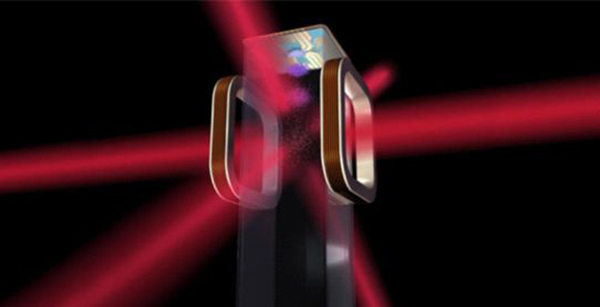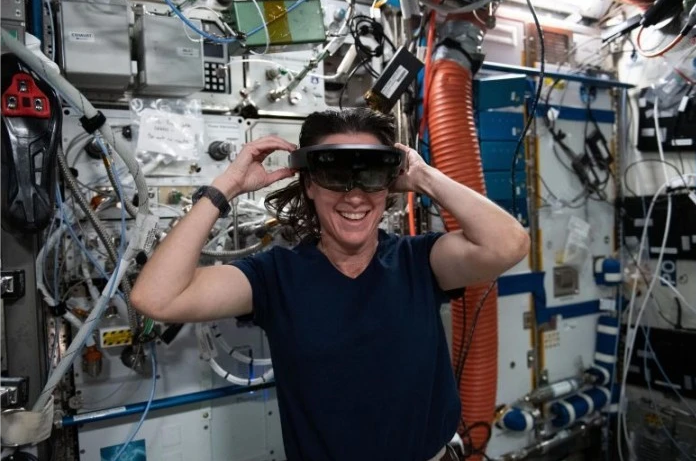创新背景
冷原子物理实验室(CAL)是由美国宇航局喷气推进实验室设计和建造的物理研究机构,通过将原子冷却到接近绝对零度(物质可以达到的最冷温度)能将气体原子的能量消除,使其保持在极低温的状态,进而探索原子的本质。超低温原子提供了一个进入量子领域的窗口,在那里物质表现出奇怪的行为,是许多现代技术的基础。
创新过程
美国宇航局(NASA)宇航员于2020年与地球上的任务团队合作,在国际空间站延长逗留期间安装升级了冷原子实验室的硬件,实现了不需要回地球就可以维护升级实验室。冷原子实验室的维护升级需要不断进行,美国宇航局喷气推进实验室、休斯顿的约翰逊航天中心和阿拉巴马州亨茨维尔的马歇尔太空飞行中心合作让NASA任务小组使用混合现实技术的产品,完成了再冷原子实验室内更换硬件,生产出超冷钾原子。

冷原子实验室是地球轨道上的第一个量子科学设施。原子被冷却后移动速度变慢,使它们更容易被研究。超冷原子可以形成称为玻色-爱因斯坦凝聚态的第五种物质状态,会在宏观尺度上显示典型的微观量子特征。
科学家们在微重力环境下可以使原子变得更冷,从而延长研究时间。通过使冷原子实验室可升级,团队成员可以随着研究的进展增加新的工具和能力,寻求新问题的答案并进行更加复杂和有影响的实验。维修活动使钾气也能在冷原子实验室中进行研究,扩展了量子化学和基础物理学实验可用的多物种气体。在这些气体中,原子只有在微重力下才能实现的超低温度下相互作用。项目目标是将冷原子实验室建设为一个不断发展的科学设施,以便速建立研究并与宇航员合作增加新的硬件能力。

冷原子实验室的硬件升级通常只能由对硬件非常熟悉的人完成,因为过程中的任何一个错误步骤都可能会影响冷原子实验室的运行能力。 宇航员必须在精细、紧密的内部组件周围工作,同时用红外摄像机观察它们。
项目采用的是微软的混合头显Hololens,看起来像包裹性的太阳镜。HoloLens将虚拟和现实世界融合在一起,使宇航员能够看到周围的区域,设备上的一个小型前向摄像头使在地球上的任务操作团队可以在大屏幕上观看宇航员视线内的东西,避免了之前从宇航员身后或上方的固定摄像机中观察的视线遮挡问题。

宇航员利用混合现实技术,可以看到操作团队在她的视野中放置的虚拟图形注释,如文字和箭头。例如,当她看着一系列电缆时,任务小组可以在她的视野中放置一个箭头,指向她需要拔掉的特定电缆。即使她的头和实现发生变化,箭头仍会指向同一个电缆位置。
混合现实被用于空间站的建设,可以使宇航员更容易单独完成一项任务。冷原子实验室的硬件更换活动实现了使用混合现实头显来改善宇航员和地球上的工程师之间的实时互动。在空间站上使用混合现实可以为执行复杂任务的宇航员提供额外的助力。
创新关键点
将混合现实技术成品运用于空间站建设,帮助宇航员和地面指挥人员实时互动,完成设施的维护升级。
创新价值
将混合现实技术运用于空间站,拓展空间站设施维护升级的方式乃至航空航天事业建设的使用工具。
Mixed reality technology improves maintenance conditions for space station facilities
NASA astronauts worked with mission teams on Earth in 2020 to install and upgrade the hardware of the Cold Atom Laboratory during their extended stay on the International Space Station, enabling the upgrade laboratory to be maintained without having to return to Earth. Nasa's Jet Propulsion Laboratory, Johnson Space Center in Houston, and Marshall Space Flight Center in Huntsville, Alabama, have teamed up to allow nasa mission teams to complete hardware replacements in the recooled atomic laboratory using mixed reality technology products to produce ultra-cold potassium atoms.
The Cold Atom Laboratory was the first quantum science facility in Earth orbit. Atoms move slower after being cooled, making them easier to study. Ultracold atoms can form a fifth state of matter called a Bose-Einstein condensed state that exhibits typical microscopic quantum signatures at the macroscopic scale.
Scientists can make atoms colder in microgravity, extending the study time. By making the Cold Atom Lab upgradeable, team members can add new tools and capabilities as research progresses, seek answers to new questions, and conduct more complex and impactful experiments. Maintenance activities allow potassium gases to be studied in cold atom laboratories, expanding the multi-species gases available for experiments in quantum chemistry and fundamental physics. In these gases, atoms interact at ultra-low temperatures that can only be achieved under microgravity. The goal of the project is to build the Cold Atom Laboratory into an evolving scientific facility to quickly establish research and to add new hardware capabilities in collaboration with astronauts.
Hardware upgrades for Cold Atom Labs can usually only be done by people who are very familiar with hardware, as any one wrong step in the process can affect the ability of Cold Atom Labs to operate. Astronauts must work around delicate, tight internal components while observing them with infrared cameras.
The project featured Microsoft's hybrid headset Hololens, which looked like wrap-around sunglasses. HoloLens blends the virtual and real worlds together, allowing astronauts to see the surrounding area, and a small forward camera on the device allows mission operations teams on Earth to see what's in the astronaut's line of sight on a large screen, avoiding the problem of line of sight previously observed from fixed cameras behind or above astronauts.
Using mixed reality technology, the astronaut can see virtual graphic annotations, such as text and arrows, that the operation team has placed in her field of vision. For example, when she looks at a series of cables, the task force can place an arrow in her field of vision pointing to the specific cable she needs to unplug. Even if her head and implementation change, the arrows will still point to the same cable location.
Mixed reality is used in the construction of the space station, making it easier for astronauts to complete a mission alone. The Cold Atom Lab's hardware replacement campaign enabled the use of mixed reality headsets to improve real-time interaction between astronauts and engineers on Earth. Using mixed reality on the space station can provide additional assistance to astronauts on complex missions.
智能推荐
基于5G的混合现实影像云平台在远程手术中的应用
2022-07-27在远程手术服务的场景中,基于5G、视频融合技术、AR技术等能力,将远程会诊专家的指导意见(手势或路径)实时融合叠加至手术现实画面中。同时采用H.264视频和AAC音频编码技术标准,双向隧道视频传输方案,使音视频流传输流畅自然。
涉及学科涉及领域研究方向利用虚拟现实技术为患者提供自动化心理治疗
2022-08-09发表在《柳叶刀精神病学》(the Lancet Psychiatry)上的有史以来规模最大的VR精神健康临床试验中,自动化疗法被证明对被诊断为精神病的患者有效。心理问题最严重的人受益最大。
涉及学科涉及领域研究方向引入3D沉浸式虚拟现实系统助力船舶设计
2022-06-29创造性地将VR与船舶设计相结合,交叉造船业和虚拟现实技术应用,提高设计过程效率并减少错误,促进船舶设计行业发展。
涉及学科涉及领域研究方向利用混合现实增强天气预报直观性
2022-07-28将混合现实技术与天气预报相结合,直观呈现极端天气的破坏力。
涉及学科涉及领域研究方向